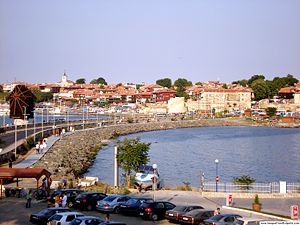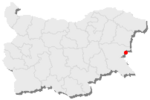Nesebar
| Ancient City of Nessebar* | |
|---|---|
| UNESCO World Heritage Site | |
 |
|
| State Party | |
| Type | Cultural |
| Criteria | iii, iv |
| Reference | 217 |
| Region** | Europe and North America |
| Inscription history | |
| Inscription | 1983 (7th Session) |
| * Name as inscribed on World Heritage List. ** Region as classified by UNESCO. |
|
Nesebar (IPA: [ˈne.se.ʙɑːr], Bulgarian: Несебър, Nesebăr, Thracian: Menebria, Greek: Μεσημβρια, Mesimvria, previously known as Mesembria) is an ancient city and a major seaside resort on the Black Sea coast of Bulgaria, located in Nesebar municipality, Burgas Province. Often referred to as the "Pearl of the Black Sea" and "Bulgaria's Dubrovnik", Nesebar is a rich city-museum defined by more than three millennia of ever-changing history.

It is a one of the most prominent tourist destinations and seaports on the Black Sea, in what has become a popular area with several large resorts—the largest, Sunny Beach, is situated immediately to the north of Nesebar.
Nesebar has on several occasions found itself on the frontier of a threatened empire, and as such it is a town with a rich history. The ancient part of the town is situated on a peninsula (previously an island) connected to the mainland by a narrow man-made isthmus, and it bears evidence of occupation by a variety of different civilisations over the course of its existence. Its abundance of historic buildings prompted UNESCO to include Nesebar in its list of World Heritage Sites in 1983.
As of September 2005[update] Nesebar has a population of 10,194 and the mayor is Nikolay Trifonov. The town lies at .
Contents |
History





Originally a Thracian settlement known as Menebria founded in the 2nd millennium BC, the town became a Greek colony when settled by Dorians from Megara at the beginning of the 6th century BC, and was an important trading centre from then on and a rival of Apollonia (Sozopol). Remains from the Hellenistic period include the acropolis, a temple of Apollo, and an agora. A wall which formed part of the Greek fortifications can still be seen on the north side of the peninsula. Bronze and silver coins were minted in the city since the 5th century BC and gold coins since the 3rd century BC.
The town fell under Roman rule in 71 BC, yet continued to enjoy privileges such as the right to mint its own coinage. It was one of the most important strongholds of the Byzantine Empire from the 5th century AD onwards, and was fought over by Byzantines and Bulgarians, being captured and incorporated in the lands of the First Bulgarian Empire in 812 by Khan Krum after a two week siege only to be ceded back to Byzantium by Knyaz Boris I in 864 and reconquered by his son Tsar Simeon the Great. During the time of the Second Bulgarian Empire it was also contested by Bulgarian and Byzantine forces and enjoyed particular prosperity under Bulgarian tsar Ivan Alexander (1331-1371) until it was conquered by Crusaders led by Amadeus VI, Count of Savoy in 1366 and handed back to Byzantium. The Slavic version of the name, Nesebar or Mesebar, has been attested since the 11th century.
Monuments from the Middle Ages include the 5-6th century Stara Mitropoliya ("old bishopric"; also St Sophia), a basilica without a transept; the 10th century church of the Virgin; and the 11th century Nova Mitropoliya ("new bishopric"; also St Stephen) which continued to be embellished until the 18th century. In the 13th and 14th century a remarkable series of churches were built: St Theodore, St Paraskeva, St Michael and St Gabriel, and St John Aliturgetos.
The capture of the town by the Turks from the Byzantine Empire in 1453 marked the start of its decline, but its architectural heritage remained and was enriched in the 19th century by the construction of wooden houses in the Eastern Rumelian style typical for the Bulgarian Black Sea Coast during this period. After the Liberation of Bulgaria from Ottoman rule in 1878, Nesebar became part of the autonomous Ottoman province of Eastern Rumelia until it united with the Principality of Bulgaria in 1886.
Around the end of the 19th century Nesebar was a small town of Greek fishermen and vinegrowers, but developed as a key Bulgarian seaside resort since the beginning of the 20th century. After the expulsion of the Greeks in 1925 a new town part was built and the historic Old Town was restored.
Churches
Nesebar is sometimes said to be the town with the highest number of churches per capita.[1], [2] Although this might be wrong, their number and variety is still impressive. Some of the most famous include:
- the Church of St Sophia or the Old Bishopric (Stara Mitropoliya) (5th-6th century)
- the Holy Mother of God Eleoussa Basilica (6th century)
- the Church of John the Baptist (11th century)
- the Church of St Stephen or the New Bishopric (Nova Mitropoliya) (11th century; reconstructed in the 16th-18th century)
- the Church of St Theodore (13th century)
- the Church of St Paraskeva (13th-14th century)
- the Church of the Holy Archangels Michael and Gabriel (13th-14th century)
- the Church of Christ Pantocrator (13th-14th century)
- the Church of St John Aliturgetos (14th century)
- the Church of St Spas (17th century)
- the Church of St Clement (17th century)
Whether built during the Byzantine, Bulgarian or Ottoman rule of the city, the churches of Nesebar represent the rich architectural heritage of the Eastern Orthodox world and illustrate the gradual development from Early Christian basilicas to medieval cross-domed churches.
Honour
Nesebar Gap on Livingston Island in the South Shetland Islands, Antarctica is named after Nesebar.
Gallery
References
- Evaluation of the International Council on Monuments and Sites, June 1983 (PDF file)
External links
---
- Folklore Ensemble "Slanchev Bryag" - Nessebar
- Official site of Nessebar Municipal Council with news and information
- Ancient Nesebar
- Photos from Nesebar
|
|||||||
|
|||||
|
||||||||||||||
